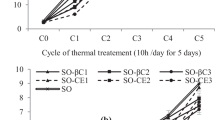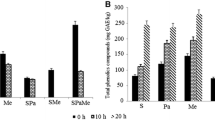Abstract
Curcumin, the active principle of turmeric, is known to act as an anti-oxidant, anti-mutagen and anti-carcinogen. This study aimed to find out the thermal and oxidative stability of soybean oil when potatoes marinated with turmeric were deep fried in the oil. Two sets of experiment were carried out. In one set, 1 L of oil was heated for 24 h (8 h daily for 3 consecutive days) and 200 g of potato chips without any marination were fried each time twice daily. Foods were fried in batches to replicate the commercial practice of the food industries. The temperature maintained during the whole experiment was at 180–190 °C i.e. at the frying temperature. About 50 ml of the oil sample was collected after every 4 h. In the second set, another 1 L of soybean oil was heated for 24 h in the similar manner and potato chips marinated with turmeric was fried twice daily. Oil samples were collected as before and comparative studies were done. The chemical parameters like acid value, peroxide value, content of 4-hydroxy-2-trans-nonenal (HNE) and fatty acid composition for all the oil samples of each set were determined. The comparative studies on peroxide value and content of HNE revealed that the antioxidant property of curcumin in turmeric helped in reducing the oxidation of the oil initially, but with increase in duration of time, the antioxidant potency got gradually reduced. The loss of unsaturated fatty acids were calculated from the fatty acid composition and it was found that loss of unsaturation in soybean oil where turmeric marinated potatoes were fried was 6.37 % while the controlled one showed 7.76 % loss after 24 h of heating. These results indicated higher thermal and oxidative stability of the soybean oil in presence of turmeric. However, the antioxidant effect gradually decreased with increase in duration of heating.



Similar content being viewed by others
Abbreviations
- PUFA:
-
Polyunsaturated fatty acids
- HNE:
-
4-hydroxy-2-trans-nonenal
- DNPH:
-
2 4-dinitrophenylhydrazine
- FA:
-
Fatty acids
- Con:
-
Control soybean oil
- Exp:
-
Experimental soybean oil
References
Aggarwal BB, Kumar A, Bharti AC (2003) Anticancer potential of curcumin: preclinical and clinical studies. Anticancer Res 23:363–398
Augustin MA, Berry SK (1983) Efficacy of the antioxidants BHA and BHT in palm olein during heating and frying. JAOCS 60:1520–1522
Boskou D (1988) Stability of frying oils in Frying of Food: Principles, changes, new approaches, pp. 174–182.
Chan EWC, Lim Y, Wong S, Lim K, Tan S, Lianto F, Yong M (2009) Effects of different drying methods on the antioxidant properties of leaves and tea of ginger species. Food Chem 113(1):166–172
Chattopadhyay I, Biswas K, Bandyopadhyay U, Banerjee RK (2004) Turmeric and Curcumin: Biological Actions and medicinal applications. Curr Sci 87(1):44–53
Cheng AL, Hsu CH, Lin JK, Hsu MM, Ho YF, Shen TS, Ko JY, Lin JT, Lin BR, Ming-Shiang W, Yu HS, Jee SH, Chen GS, Chen TM, Chen CA, Lai MK, Pu YS, Pan MH, Wang YJ, Tsai CC, Hsieh CY (2001) Phase I clinical trial of curcumin, a chemopreventive agent, in patients with high-risk or pre-malignant lesions. Anticancer Res 21(4B):2895–2900
Duvoix A, Blasius R, Delhalle S, Schnekenburger M, Morceau F, Henry E, Dicato M, Diederich M (2005) Chemopreventive and therapeutic effects of curcumin. Cancer letters 223:181–190
Hsu CH, Cheng AL (2007) Clinical studies with curcumin. Adv Exp Med Biol 595:471
Hwang H-S, Winkler-Moser JK, Bakota EL, Berhow MA, Liu SX (2013) Antioxidant Activity of Sesamol in Soybean Oil Under Frying Conditions. J Am Oil Chem Soc 90:659–666
Joe B, Lokesh BR (1994) Role of capsaicin, curcumin and dietary n-3 fatty acids in lowering the generation of reactive oxygen species in rat peritoneal macrophages. Biochim Biophys Acta 1224:255–263
Lim GP, Chu YF, Beech W, Frantschy SA, Cole GM (2001) The curry spice curcumin reduces oxidative damage and amyloid pathology in an Alzheimer transgenic mouse. J Neurosci 21:8370–8377
Mahakunakorn P, Tohda M, Murakami Y, Matsumoto K, Watanabe H, Vajragupta O (2003) Cytoprotective and cytotoxic effects of curcumin: dual action on H2O2 induced oxidative cell damage in NG108-15 cells. Biol Pharm Bull 26:725–728
Metcalfe LD, Schmidt ZA, Pelkar JR (1966) Rapid preparation of fatty acid methyl esters from lipids for Gas chromatographic analyses. Analytical chemistry 38:514–515
Phan TT, See P, Lee ST, Chan SY (2001) Protective effects of curcumin against oxidative damage on skin cell in vitro: its implication for wound healing. J Trauma 51:927–931
Pulla Reddy A, Lokesh BR (1992) Studies on spice principles as antioxidant in the inhibition of lipid peroxidation of rat liver microsomes. Mol Cell Biochem 111:117–124
Rubalya Valantina S, Neelamegam P (2012) Antioxidant potential in vegetable oil. Res J Chem Environ 16(2):87–94
Ruby AJ, Kuttan G, Dinesh K, Rajasekharan KN, Kuttan R (1995) Antitumor and antioxidant activity of natural curcuminoids. Cancer Lett 94:79–83
Seppanen CM, Csallany AS (2004) Incorporation of the Toxic Aldehyde 4-Hydroxy-2-trans-nonenal into Food Fried in Thermally Oxidized Soybean oil. JAOCS 81:1137–1141
Sharma OP (1976) Antioxidant activity of curcumin and related compounds. Biochem Pharmacol 25:1811–1812
Sharma S, Kulkarni SK, Chopra K (2006) Curcumin, the active principle of turmeric (Curcuma longa), ameliorates diabetic nephropathy in rats. Clin Exp Pharmacol Physiol 33(10):940–945
Song EK (2001) Diarylheptanoids with free radical scavenging and hepato protective activity in vitro from Curcuma longa. Planta Med 67:876–877
Subramanian M, Sreejayan Rao MNA, Devasagayam TPA, Singh BB (1994) Diminution of singlet oxygen induced DNA damage by curcumin and related antioxidants. Mutat Res 311:249–255
Suresh D, Manjunatha H, Srinivasan K (2007) Effect of heat processing of spices on the concentrations of their bioactive principles: Turmeric (Curcuma longa), red pepper (Capsicum annuum) and black pepper (Piper nigrum). Journal of Food Composition and Analysis 20:346–351
Tatsuhiro U, Naohiro G, Shun W (2002) Method for Analysis of 4-Hydroxy 2-(E) nonenal with Solid-Phase Microextraction. Lipids 37:621–626
Tayyem RF, Heath DD, Al-Delaimy WK, Rock CL (2006) Curcumin content of Turmeric and Curry Powders. Nutrition and Cancer 55(2):126–131
Tsaknis J, Lalas S, Protopapa E (2002) Effectiveness of the antioxidants BHA and BHT in selected vegetable oils during intermittent heating. Grasas y Aceites 53(2):199–205
Tyagi VK, Vasishtha AK (1996) Changes in the characteristics and composition of oils during deep-fat frying. JAOCS 73(4):499–506
Tyagi VK, Vasishtha AK, Sinha S (1998) Evaluation of frying oils in deep fat frying. JOTAI 30(1):3–7
Unnikrishnan MK, Rao MN (1995) Inhibition of nitric-induced oxidation of hemoglobin by curcuminoids. Pharmazie 50:490–492
Wickenberg J, Ingemansson SL, Hlebowicz J (2010) Effects of Curcuma longa (turmeric) on postprandial plasma glucose and insulin in healthy subjects. Nutr J 9:43–47
Yoon SH, Kim SK, Kim KH, Kwon TW, Teah YK (1987) Evaluation of physicochemical changes in cooking oil during heating. JAOCS 64:870–873
Acknowledgement
We sincerely acknowledge the contribution of Late Dr. Santinath Ghosh, Associate Professor, Dept. of Chemical Technology, University of Calcutta, who actually initiated the work and left untimely for heavenly abode, for his never forgettable inspiration and contribution.
Author information
Authors and Affiliations
Corresponding author
Rights and permissions
About this article
Cite this article
Banerjee, A., Ghosh, S. & Ghosh, M. Anti-oxidative effect of turmeric on frying characteristics of soybean oil. J Food Sci Technol 52, 1760–1765 (2015). https://doi.org/10.1007/s13197-013-1156-y
Revised:
Accepted:
Published:
Issue Date:
DOI: https://doi.org/10.1007/s13197-013-1156-y




